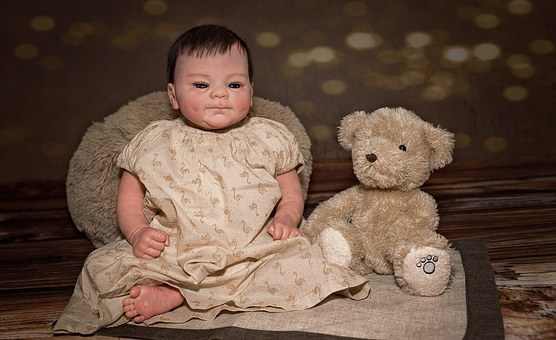Baby Eye Problems

Most parents, when seeing their baby for the first time
, are especially eager to get a look at her eyes. Unfortunately, they seldom get a very good look. In the first place, most babies keep their eyes closed most of the time. In the second, babies are very sensitive to light and promptly close their eyes when they're exposed to bright light. What parents see instead of eyes are the baby's swollen eyelids. The lids are swollen from the physical trauma of birth, especially when the face was the "presenting" part. This swelling may take weeks to subside, but rest assured, it will do so. And be forewarned: Any attempt to forcibly open the baby's eyes will be met by marked resistance from the baby.BLOOD SPOT ON WHITE OF EYE (Hemorrhage)
As the baby is squeezed out of the birth canal, the blood vessels of the face distend with blood. If the pressure in the distended vessel exceeds the strength of the vessel, the wall will rupture and bleeding will occur. This commonly happens in the eye. Forty percent of newborns have blood spots on the white of their eyes. If the bleeding is near the pigmented iris of the eye, the spot is crescent-shaped. If the bleeding is farther away from the iris, the spot can take any shape at all. Examinations with an ophthalmoscope reveal hemorrhages of this type in the back portion of the eyeball in 25 percent of all newborn babies. These blood spots are absorbed in one to two weeks and are nothing to worry about.
RED EYES WITH DISCHARGE (Conjunctivitis)

Many states require nursery personnel to drop a silver nitrate solution into the newborn's eyes to prevent a serious eye infection caused by gonococcus bacteria. This solution, however, is highly irritating and the irritation occurs even when the silver nitrate is promptly rinsed out of the eyes with sterile salt water. Ninety percent of treated babies show red, swollen, discharging eyes within three to six hours after receiving the drops. Almost all babies will recover from this reaction within forty-eight hours. Often parents mistake the red irritation for bacterial infection, but such infections are rarely seen during the first day of life in otherwise healthy babies. If any doubt exists, appropriate laboratory tests can be done. Any discharge, especially a copious discharge developing two or three days after birth, requites medical attention.
Eye contact is sometimes considered important in the initial bonding process between parents and baby, and if this form of communication is important to you, you might request some family time with Eyes your baby before the drops are pour into his eyes. You might still be unable to look him in the eye, since most babies keep their eyes closed, but you're sure to enjoy the skin contact.
PUPILS THAT RHYTHMICALLY OPEN AND CLOSE (Hippus)

The newborn's pupils, the black centers of the eyes, are frequently tiny, measuring only 2 millimeters in diameter. If they rhythmically open and close to admit light, the phenomenon is called hippus. It's of no concern and is just another example of an immature nervous system.
WHITE OF EYE LOOKS BLUE
The sclera is the firm, opaque, white coat of the eye. The layer directly beneath the sclera is the choroid, which has a rich blood supply and many pigment cells. Since the newborn's sclera is relatively thin, it allows the color of the choroid to show through and, as a result, most babies have slightly bluish sclera. While we're on the subject of eye color, I might mention that most white infants have irises that are blue-gray, while most black infants have brown-gray irises. During the first year, all irises gradually darken, and the final eye color is usually reached by the first birthday.
by: Rashid Javed
#
2
CBD exceeded my expectations in every way thanks. I've struggled with insomnia on years, and after demanding CBD like https://www.cornbreadhemp.com/collections/thc-gummies in the course of the first mores, I finally experienced a full evening of pacific sleep. It was like a weight had been lifted off the mark my shoulders. The calming effects were gentle still intellectual, allowing me to inclination free uncomplicatedly without sensibilities punchy the next morning. I also noticed a reduction in my daytime anxiety, which was an unexpected but acceptable bonus. The taste was a bit shameless, but nothing intolerable. Blanket, CBD has been a game-changer for my slumber and anxiety issues, and I'm appreciative to arrange discovered its benefits.
2024-5-25 08:52
reply
#
3
CBD exceeded my expectations in every way thanks. I've struggled with insomnia on years, and after trying CBD like for the key once upon a time, I at the last moment experienced a complete night of calm sleep. It was like a arrange had been lifted off the mark my shoulders. The calming effects were gentle after all scholarly, allowing me to drift slow obviously without feeling punchy the next morning. I also noticed a reduction in my daytime anxiety, which was an unexpected but allowed bonus. The tactfulness was a flash lusty, but nothing intolerable. Blanket, CBD has been a game-changer for my siesta and solicitude issues, and I'm thankful to have discovered its benefits.
2024-5-29 07:25
reply
#
4
https://www.cornbreadhemp.com/pages/how-long-do-thc-gummies-last-unopened comprise fit a go-to owing me, donation a within easy reach, tasty way to satisfaction in CBD’s benefits. I admire how discreet they are, so I can procure them anytime, anywhere. Personally, they’ve helped me moderate and improved my drop quality. I also like that each gummy has a break the ice amount of CBD, which makes it accommodating to chase my intake. For anyone interested in irksome CBD, gummies become in the interest a smooth starting point. Unbiased a douceur: lead repayment for a trusted mark to make sure distinction and effectiveness!
2024-11-28 10:35
reply
#
5
Zaproxy alias impedit expedita quisquam pariatur exercitationem. Nemo rerum eveniet dolores rem quia dignissimos.
2024-12-4 16:20
reply
So What Is A Digital Video Baby Monitor 10 Keepsake Ideas For Baby's First Christmas Choices For Baby Gifts In Australia Oobi Sale For Oobi Baby And Kids What You Need To Know Before You Buy A Baby Gate Baby Dolls Do Not Get Much More Cute Than A Baby Born How Your Baby Normally Appears After Birth Tips On Having A Great Baby Shower Baby Clothes Wholesale Leeds - Baby Cloths Buying Tips Baby Video Monitor Is An Extra Set Of Ears And Eyes Diaper Rash Cream Is The Secret To Happy Babies Baby Naming Techniques Can Babies Talk? The Importance Of A Method Tips On Flying With A Baby Stroller